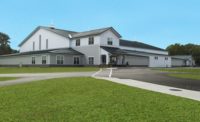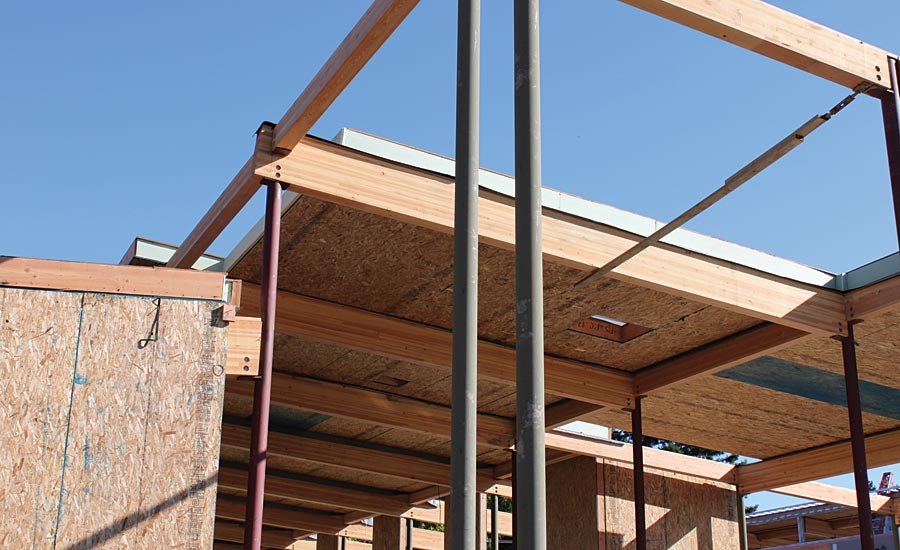Integrating SIPs with Metal Structure Buildings
Achieving high-performance building envelopes

Although structural insulated panels often are used as the primary structural elements in light commercial and residential buildings, many project teams also use the panels as skins over metal structural frames to provide a high-performance building envelope.

Although structural insulated panels often are used as the primary structural elements in light commercial and residential buildings, many project teams also use the panels as skins over metal structural frames to provide a high-performance building envelope.

Although structural insulated panels often are used as the primary structural elements in light commercial and residential buildings, many project teams also use the panels as skins over metal structural frames to provide a high-performance building envelope.

Although structural insulated panels often are used as the primary structural elements in light commercial and residential buildings, many project teams also use the panels as skins over metal structural frames to provide a high-performance building envelope.




Although structural insulated panels often are used as the primary structural elements in light commercial and residential buildings, many project teams also use the panels as skins over metal structural frames to provide a high-performance building envelope.
To set the stage for why project teams combine SIPs with metal structural frames, it is helpful to review a specific example.
The Little Big Horn College Health & Wellness Center (Crow Agency, Montana) includes an NCAA gymnasium, seating approximately 1,300 people with spaces for aerobics/community gathering, weight lifting and cardiovascular fitness, locker rooms, and support facilities. The college (of the Apsàalooke Nation—Crow Tribe of Montana) built the facility to serve its students, as well as the surrounding community.
The Health & Wellness Center project team faced a daunting schedule. Time was running out to use a government grant for the project, so the team needed to start construction before they finalized the building design. Adding to the timing challenges, they had to construct the building’s shell during one of the coldest Montana winters in 20 years.
LEED Standards
On top of requiring rapid completion, the college wanted a very green, energy-efficient building, targeted to LEED Platinum standards. This commitment to the environment reinforces the center’s role in supporting healthy living, and respects the tribe’s historic, cultural and artistic way of life.
Since the owner, architect and general contractor used an Integrated Project Delivery approach, all parties had a strong stake in working together to address the schedule and green building needs. Rather than operating under separate contracts for design and construction, with the IPD the participants all signed one contract focused on successful completion of the project. “This allowed every team member to bring their best ideas to the table and collaborate on solutions,” says Scott Moore, project manager with BNIM Architects.
One of those ideas was to use SIPs for the exterior walls and roof. “SIPs meet a number of needs with just one system,” says Doug Morley, principal architect with Springer Group Architects. “They install fast, insulate well and are strong. Other than in the large gymnasium, this reduced the need for a secondary support structure in the building and saved us a bunch of time and money.”
Echoing Morley’s comments, contractor Glen Kamerman, partner with Kamerman Construction says, “The SIPs were really accurately constructed and went together well. Using SIPs probably saved about 15 to 20 percent or more on the installation time. It also eliminated the need to heat the walls during winter construction, as would have been necessary with concrete masonry units.”
“SIPs really helped us meet the accelerated project schedule,” adds Matt Anderson, owner of Compass Consulting Engineers. “SIP shop drawings were done concurrently with design, so by the time we released the foundation package, the SIPs were being fabricated in the shop.”
In addition to rapid construction and high strength, the SIPs play a key role in the building’s high energy efficiency design. The large-size panels have fewer gaps requiring sealing than other construction methods and provide continuous insulation throughout the walls and roof. “Energy savings is a big part of getting to the LEED Platinum goal,” says Ben Mitchell, project manager with Fisher Construction, general contractor.
Reasons to Use SIPs
The 1,300-seat gymnasium portion of the Little Big Horn College Health & Wellness Center illustrates the types of buildings that are especially suited for using SIPs as skins over metal structural frames. Specifically, buildings needing large, open interior spaces, for which an energy-efficient envelope is crucial.
Two of the Little Big Horn College Health & Wellness Center project players summarize the role SIPs play in such spaces:
“They work well in long spans and have high shear and diaphragm values. This was especially crucial to help create the wide-open space in the project’s gymnasium.”
– Matt Anderson, owner of
Compass Consulting Engineers
“It’s hard to get a gym to meet any energy code, let alone LEED Platinum, but the SIPs provide a super energy-efficient envelope—much better than we could get from other products for the same labor and material costs.”
– Ben Mitchell, project manager, Fisher Construction
In addition to gymnasiums, other examples of buildings needing open spaces and an energy-efficient envelope include churches, community centers, cold storage and some factories and barns.
Why SIPs?
Building teams choose SIPs for commercial/institutional buildings and residences for four key reasons:
- Energy efficiency
- Labor savings
- Lower jobsite waste
- Improved indoor air quality
Energy Efficiency
SIPs provide continuous insulation over a high percentage of the structure without having to add subsequent layers of insulation. Code required continuous insulation dramatically reduces air leakage from the building and has fewer thermal bridges than other building methods. As a result, SIPs can help lower energy costs for space heating and cooling by up to 60 percent above standards set forth in the 2006 International Energy Conservation Code.
Testing by the U.S. Dept. of Energy’s Oak Ridge National Laboratory showed that SIP structures are up to 15 times more airtight than stick framed walls insulated with fiberglass batts. A SIP structure had an air leakage rate of only 8 cubic-feet per minute (at 50 Pascals of pressure) compared to stick framing which leaked air at 121 cubic-feet per minute. This dramatic difference is because SIP-built walls and roofs have far fewer gaps to be sealed. The lab also found for similar wall thicknesses, SIPs were 47 percent better at resisting heat flow than stick framing. A 3.5-inch-thick foam core SIP wall had a 14.09 R-value versus 9.58 R-value for 2-by-4 studs at 16 inches-on-center with fiberglass insulation. The SIP structure’s 14.09 whole-wall R-value even out-performed the 13.69 R-value of “advanced framing” with 2-by-6 studs at 24 inches-on-center.
Labor Savings
Because SIPs are built in a factory, they reduce jobsite labor needed for framing and insulation. The panels eliminate the need to cut and install dozens of studs and other framing members throughout the walls and roof. And, because the panels arrive on the job site with pre-cut window and door openings, there is no need to frame-out openings with jack studs and headers. “With the pre-built panels, you just have to piece the building together like a puzzle,” explains Glen Kamerman, partner with Kamerman Construction. Pre-cut electrical chases also eliminate the time-consuming need to drill through dozens of studs to install wiring.
Lower Jobsite Waste
Traditional building practices—notably stick framing—generate large volumes of scrap from cut-offs for studs, joists and other framing members. SIPs are planned and made in a factory to eliminate such waste. SIPs can help reduce construction waste by up to two-thirds.
Improved Indoor Air Quality
In addition to helping keep heated or cooled air inside buildings, SIPs’ airtight nature also helps seal out common pollutants for healthier indoor air. Blocking or slowing infiltration of radon, pollen, volatile organic compounds, dust and the like contributes to a healthier and more comfortable indoor environment.
Looking for a reprint of this article?
From high-res PDFs to custom plaques, order your copy today!








